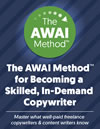What Villains Can Teach You about Writing Persuasive Copy

I’m not a fan of superhero movies, but recently on a date night, my husband and I watched the new Wonder Woman movie.
I admit … it was better than I expected. But when we got home, I got to thinking about why these types of movies seem to work so well.
Sure, there has to be a well-written script. And the actors and the action scenes have to be convincing.
But there’s always a common thread or plot line in all of these movies that just draws people to them. And we’re talking millions of people.
In the case of Wonder Woman, the movie has already grossed $750 million worldwide.
What’s the one thing they have in common, that draws crowds like a magnet?
The fight of good against evil.
The superhero is always pitted against an evil villain. And when they triumph over the villain, the hero wins over the hearts and minds of the people she is trying to save.
Nothing new here, right? Unless, of course, you apply this concept of heroes and villains to copywriting.
Like how Ben Settle does. Ben is a master email marketer and copywriter. He’s even invented a whole new type of copywriting, “client-less copywriting,” where you can earn a six-figure income without having clients. (You can learn more about it here.)
What makes Ben’s type of copywriting stand out is the way he uses villains in his copy. Ben developed his style of villain copywriting after Disney. The reason Disney stories are so popular is because they always feature a villain.
Disney even explains how it works in an episode of The Wonderful World of Disney, titled, “Disney’s Greatest Villains.” Basically, the episode explained that adding a villain to the story is what keeps people from getting bored.
Ben Settle says it works the exact same way in email marketing. Regardless of what you sell (product, service, fundraising, etc., doesn’t matter) or who you sell to, your product is the hero, riding in on his noble steed and slaying the bad guy.
But, if the bad guy is not seen as a truly credible threat, something evil and malicious, and who will destroy the world (or, rather, the prospect’s world), then your product will not look nearly as effective as it really is.
In fact, it’s the villain who actually defines the hero, not vice versa. Without an evil, powerful, diabolical villain, the hero is just another ordinary chump walking the streets. That’s why Ben says if you want to write really persuasive copy, you should spend a lot of time defining the problem so your solution will look like a hero.
In your copy, you don’t even have to spend much time explaining the solution. Nope, instead, focus more on the problem. Remember, just as Disney does and all those superhero movies do, without that villain, your hero has no purpose. It has no context. And, it has no reason to exist at all — much less be bought.
But what does this mean exactly? How do you turn the problem into a villain? Well, Ben says villains in persuasive writing can take all kinds of forms — from physical and emotional pain, to insecurities and loneliness, to feelings of betrayal, fear, frustration, and outrage, and the list goes on.
Here’s how you do it when you are writing marketing emails:
Write down every kind of pain — real or imagined — your target market feels and is experiencing. Don’t stop with just the obvious ones. Write down all the not-so-obvious ones, too.
If you do this, you will be amazed at the sheer number of different villains that come from doing this exercise. Then, write about a different one of these villains each time you are writing an email and plug your product at the end as a way to defeat that villain.
It might take you a few practice runs to get the villains technique right. But imagine the fun you’ll have doing this. More importantly, imagine how much better you’ll be at writing persuasive copy for your client.
And when that happens, you become a hero to your client. And they reward you with lots more paid projects, which means lots more money.
Do you have any questions about Ben’s villains approach to copywriting? Please leave a comment below so we can help.

The AWAI Method™ for Becoming a Skilled, In-Demand Copywriter
The AWAI Method™ combines the most up-to-date strategies, insights, and teaching methods with the tried-and-true copywriting fundamentals so you can take on ANY project — not just sales letters. Learn More »
This article really opened my eyes to great ways to express a message. I'm using the ideas talking to others and I'm amazed at how they can see the perspective I am talking about, as well as being able to discuss other aspects of the same issue. This is really eye opening.
Guest (James R Morris) –
Sandy,
I spent many years writing about 'real' villains, in 'real' life. So, I should find it easy to cast 'life's problems' as the NEW villains in my life as a Copywriter.
Excellent idea Ben has come up with for sure. And our solutions to the problems will become the 'Hero' of these sales sagas.
I like it. It has a certain solid symmetry to it.
D.S.N.
Dark-n-Stormy-Night –